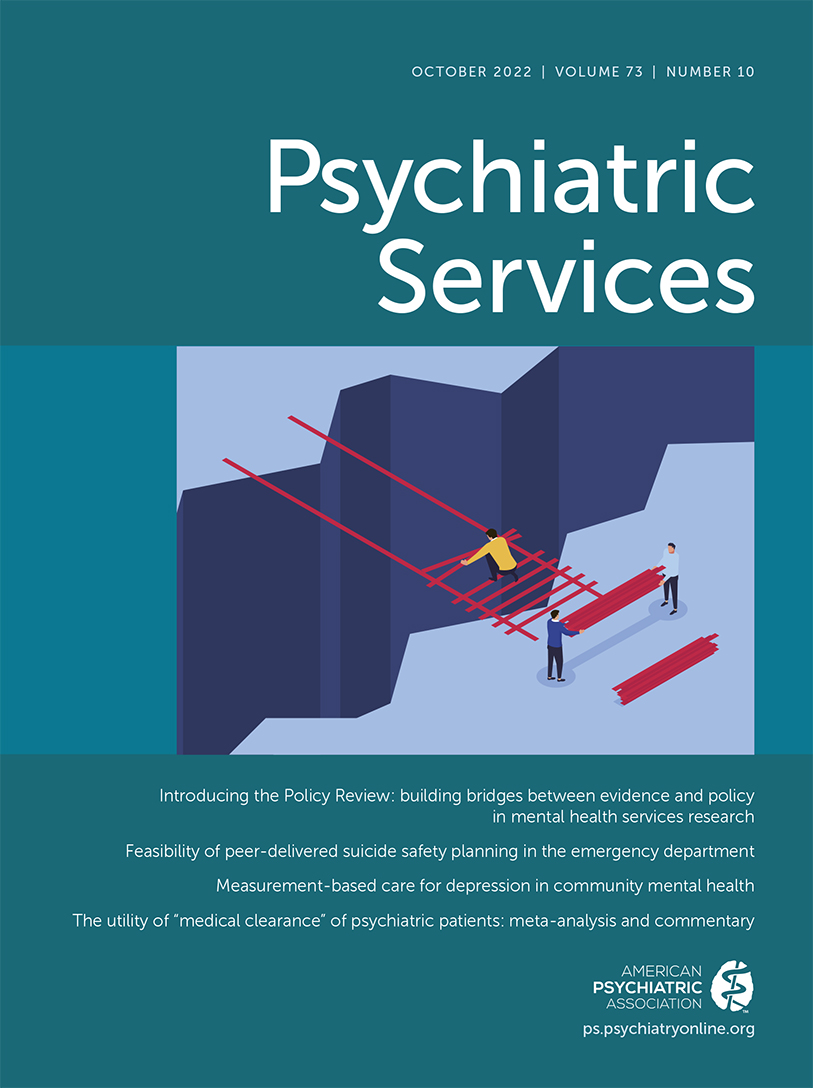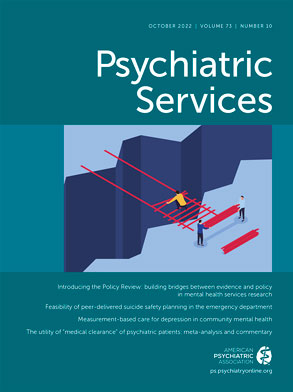Comparing Service Use and Costs of Individual Placement and Support With Usual Vocational Services for Veterans With PTSD
Abstract
Objective:
Methods:
Results:
Conclusions:
HIGHLIGHTS
Methods
Sources and Measures of Cost Data
Analytic Methods
Results
Baseline Characteristics
| IPS (N=271) | TW (N=270) | |||
|---|---|---|---|---|
| Characteristic | N | % | N | % |
| Sex | ||||
| Male | 224 | 83 | 218 | 81 |
| Female | 47 | 17 | 52 | 19 |
| Race-ethnicityb | ||||
| White | 138 | 51 | 136 | 50 |
| Black | 115 | 42 | 110 | 41 |
| Other race | 32 | 12 | 36 | 13 |
| Latinx | 43 | 16 | 47 | 17 |
| Marital status | ||||
| Never married | 68 | 25 | 67 | 25 |
| Married | 89 | 33 | 84 | 31 |
| Divorced | 82 | 30 | 79 | 29 |
| Education | ||||
| Less than college | 54 | 20 | 43 | 16 |
| College credit or degree | 201 | 74 | 210 | 78 |
| Postgraduate credit or degree | 16 | 6 | 17 | 6 |
| Comorbid mental health conditionc | ||||
| Current major depressive episode | 87 | 32 | 83 | 31 |
| Past major depressive episode | 183 | 68 | 173 | 64 |
| Agoraphobia | 64 | 24 | 59 | 22 |
| Panic disorder | 37 | 14 | 66 | 24 |
| Social anxiety disorder | 35 | 13 | 28 | 10 |
| Past-year alcohol use disorder | 54 | 20 | 78 | 29 |
| Age (M±SD years) | 42.5±10.7 | 41.9±11.2 | ||
| PTSD duration (M±SD years) | 13.3±11.6 | 13.4±11.3 | ||
Utilization, Inpatient Days, and Cost of High-Intensity Services
| Users of health servicesb | Health care encounters | |||||||||
|---|---|---|---|---|---|---|---|---|---|---|
| IPS (N=271) | TW (N=270) | IPS (N=271) | TW (N=270) | IPS vs. TW | ||||||
| Service type | N | % | N | % | M | SD | M | SD | Mean difference | 95% CI |
| Vocational rehabilitation | 248 | 92 | 248 | 92 | 30.9 | 25.3 | 13.6 | 14.3 | 17.3** | 13.8 to 20.8 |
| General medical hospitalization | 35 | 13 | 31 | 12 | .21 | .73 | .17 | .66 | .04 | −.08 to .2 |
| Psychiatric hospitalization | 26 | 10 | 31 | 12 | .20 | 1.0 | .14 | .45 | .06 | −.07 to .2 |
| Domiciliary or residential care | 19 | 7 | 20 | 7 | .10 | .41 | .09 | .33 | .01 | −.05 to .07 |
| ED or urgent care | 163 | 60 | 174 | 64 | 1.8 | 2.8 | 1.9 | 2.8 | −.1 | −.6 to .4 |
| Outpatient medical care | 265 | 98 | 267 | 99 | 32.2 | 32.2 | 35.7 | 31.5 | −3.5 | −8.9 to 1.9 |
| Outpatient mental health care | 268 | 99 | 267 | 99 | 41.6 | 49.1 | 39.6 | 42.5 | 2.0 | −5.7 to 9.7 |
| Pharmacy | 262 | 97 | 265 | 98 | 52.1 | 53.1 | 60.6 | 62.4 | −8.5 | −18.2 to 1.3 |
| Housing services | 91 | 34 | 101 | 37 | 6.4 | 15.9 | 7.2 | 15.6 | −.8 | −3.5 to 1.8 |
| Ancillary services | 39 | 14 | 53 | 20 | .4 | 1.9 | .8 | 2.8 | −.4 | −.8 to .02 |
| Administrative services | 184 | 68 | 204 | 76 | 2.7 | 3.5 | 3.4 | 3.5 | −.7* | −1.3 to −.1 |
| Users of health servicesb | Health care encounters | ||||||||||
|---|---|---|---|---|---|---|---|---|---|---|---|
| IPS (N=271) | TW (N=270) | IPS (N=271) | TW (N=270) | IPS vs. TW | |||||||
| Service type | N | % | N | % | M | SD | M | SD | Mean difference | 95% CI | |
| Vocational rehabilitation | 145 | 54 | 59 | 22 | 3.1 | 6.3 | 1.1 | 4.6 | 2.0** | 1.1 to 2.9 | |
| General medical hospitalization | 24 | 9 | 24 | 9 | .14 | .58 | .13 | .50 | .01 | −.08 to .1 | |
| Psychiatric hospitalization | 11 | 4 | 10 | 4 | .08 | .43 | .07 | .38 | .01 | −.06 to .08 | |
| Domiciliary or residential care | 12 | 4 | 12 | 4 | .06 | .30 | .06 | .31 | .0 | −.05 to .05 | |
| ED or urgent care | 103 | 38 | 101 | 37 | 1.0 | 1.9 | .9 | 1.5 | .1 | −.2 to .4 | |
| Outpatient medical care | 240 | 89 | 244 | 90 | 17.9 | 21.0 | 17.7 | 19.3 | .3 | −3.2 to 3.7 | |
| Outpatient mental health care | 220 | 81 | 224 | 83 | 14.2 | 27.8 | 15.0 | 30.3 | −.8 | −5.7 to 4.2 | |
| Pharmacy | 237 | 87 | 247 | 92 | 28.0 | 34.1 | 32.3 | 38.9 | −4.4 | −10.5 to 1.8 | |
| Housing services | 55 | 20 | 68 | 25 | 2.6 | 8.2 | 2.9 | 8.2 | −.3 | −1.7 to 1.1 | |
| Ancillary services | 21 | 8 | 27 | 10 | .3 | 1.5 | .3 | 1.3 | .0 | −.2 to .3 | |
| Administrative services | 128 | 47 | 154 | 57 | 1.8 | 3.6 | 1.8 | 2.5 | .0 | −.5 to .6 | |
| IPS (N=271) | TW (N=270) | IPS vs. TW | ||||||||
|---|---|---|---|---|---|---|---|---|---|---|
| Service type | M | 95% CI | Median | IQR | M | 95% CI | Median | IQR | Mean difference | 95% CI |
| Vocational rehabilitation | 6,388 | 5,512–7,264 | 4,854 | 9,696 | 2,549 | 2,148–2,950 | 1,479 | 3,213 | 3,839** | 2,874 to 4,803 |
| General medical hospitalization | 2,596 | 1,481–3,710 | 0 | 0 | 2,069 | 1,102–3,036 | 0 | 0 | 526 | −950 to 2,003 |
| Psychiatric hospitalization | 1,687 | 733–2,641 | 0 | 0 | 1,498 | 870–2,126 | 0 | 0 | 189 | −954 to 1,332 |
| Domiciliary or residential care | 2,163 | 890–3,437 | 0 | 0 | 1,938 | 1,019–2,857 | 0 | 0 | 225 | −1,346 to 1,796 |
| ED or urgent care | 889 | 727–1,051 | 456 | 1,236 | 934 | 766–1,102 | 475 | 1,245 | −45 | −278 to 189 |
| Outpatient medical care | 6,100 | 5,326–6,875 | 3,839 | 6,781 | 6,542 | 5,661–7,424 | 4,400 | 5,795 | −442 | −1,615 to 731 |
| Outpatient mental health care | 6,976 | 6,031–7,922 | 4,169 | 7,320 | 6,321 | 5,573–7,069 | 4,342 | 6,170 | 655 | −551 to 1,862 |
| Pharmacy | 1,325 | 889–1,761 | 260 | 893 | 1,291 | 783–1,799 | 318 | 819 | 33 | −636 to 703 |
| Housing services | 1,295 | 884–1,705 | 0 | 476 | 1,282 | 939–1,626 | 0 | 709 | 13 | −523 to 548 |
| Ancillary services | 37 | 9–66 | 0 | 0 | 58 | 24–92 | 0 | 0 | −20 | −65 to 24 |
| Administrative services | 234 | 176–291 | 65 | 224 | 298 | 246–349 | 109 | 421 | −64 | −141 to 13 |
| Total | 29,691 | 26,427–32,955 | 20,683 | 24,803 | 24,781 | 22,002–27,560 | 17,188 | 22,949 | 4,910* | 622 to 9,198 |
Total Cost and Utilization of Health Services
| IPS (N=271) | TW (N=270) | IPS vs. TW | ||||||||
|---|---|---|---|---|---|---|---|---|---|---|
| Service type | M | 95% CI | Median | IQR | M | 95% CI | Median | IQR | Mean difference | 95% CI |
| Vocational rehabilitation | 966 | 756–1,176 | 0 | 1,293 | 385 | 203–567 | 0 | 0 | 581** | 303 to 858 |
| General medical inpatient care | 3,397 | 1,268–5,526 | 0 | 0 | 2,754 | 946–4,562 | 0 | 0 | 643 | −2,151 to 3,437 |
| Psychiatric inpatient care | 1,182 | 220–2,143 | 0 | 0 | 915 | 253–1,577 | 0 | 0 | 266 | −902 to 1,435 |
| Domiciliary or residential care | 2,823 | 620–5,026 | 0 | 0 | 1,708 | 509–2,907 | 0 | 0 | 1,115 | −1,396 to 3,626 |
| ED or urgent care | 687 | 523–851 | 0 | 782 | 631 | 500–763 | 0 | 780 | 56 | −155 to 266 |
| Outpatient medical care | 5,884 | 4,823–6,945 | 2,312 | 5,919 | 5,397 | 4,517–6,277 | 2,897 | 5,652 | 487 | −892 to 1,866 |
| Outpatient mental health care | 3,383 | 2,738–4,028 | 1,523 | 3,604 | 3,652 | 2,835–4,468 | 1,872 | 3,590 | −269 | −1,309 to 771 |
| Pharmacy | 1,100 | 668–1,532 | 140 | 458 | 1,352 | 437–2,267 | 197 | 640 | −252 | −1,263 to 758 |
| Housing services | 943 | 568–1,319 | 0 | 0 | 1,072 | 688–1,456 | 0 | 0 | −129 | −666 to 408 |
| Ancillary services | 38 | 12–64 | 0 | 0 | 43 | 11–75 | 0 | 0 | −5 | −47 to 36 |
| Administrative services | 419 | 215–622 | 0 | 223 | 381 | 218–544 | 34 | 253 | 37 | −223 to 298 |
| Total | 20,821 | 16,143–25,499 | 8,284 | 19,593 | 18,292 | 14,826–21,757 | 8,886 | 15,458 | 2,530 | −3,295 to 8,354 |
Utilization and Costs of Vocational Services
Discussion
Conclusions
Acknowledgments
References
Information & Authors
Information
Published In
History
Keywords
Authors
Competing Interests
Funding Information
Metrics & Citations
Metrics
Citations
Export Citations
If you have the appropriate software installed, you can download article citation data to the citation manager of your choice. Simply select your manager software from the list below and click Download.
For more information or tips please see 'Downloading to a citation manager' in the Help menu.
View Options
View options
PDF/EPUB
View PDF/EPUBLogin options
Already a subscriber? Access your subscription through your login credentials or your institution for full access to this article.
Personal login Institutional Login Open Athens loginNot a subscriber?
PsychiatryOnline subscription options offer access to the DSM-5-TR® library, books, journals, CME, and patient resources. This all-in-one virtual library provides psychiatrists and mental health professionals with key resources for diagnosis, treatment, research, and professional development.
Need more help? PsychiatryOnline Customer Service may be reached by emailing PsychiatryOnline@psych.org or by calling 800-368-5777 (in the U.S.) or 703-907-7322 (outside the U.S.).

